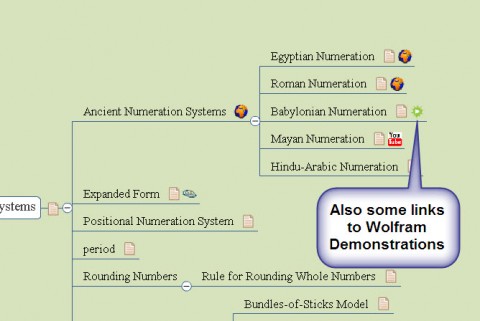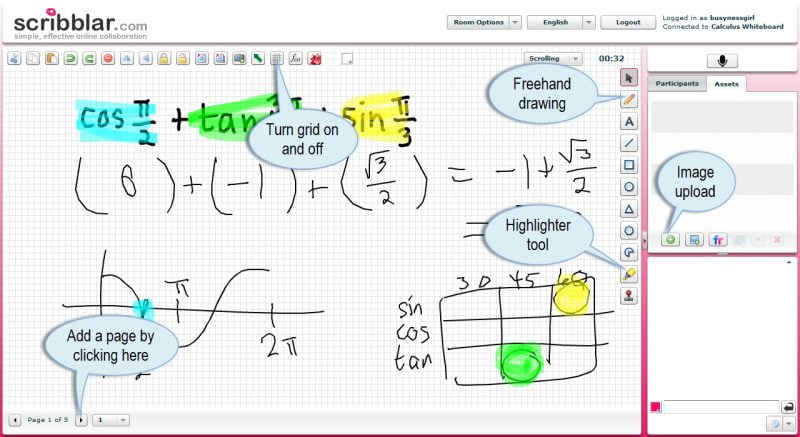Originally, I started this post with the title “What I’m doing with Wolfram|Alpha” and then I revised it, because it’s not just me using Wolfram|Alpha. My students are using it too. Here are some of the things we’re doing:
Discussion Boards: Wolfram|Alpha + Jing = Awesome
Before Wolfram|Alpha, it could take several steps to get a graph or the solution to solving an equation to the discussion board in an online class. You had to use some program to generate the graph or the equations, then make a screenshot of the work, then get that hyperlink, image, or embed code to the discussion board.
With Wolfram|Alpha, sometimes a simple link suffices. Suppose, for example, I needed to explain the last step in a calculus problem where the students have to find where there is a horizontal tangent line. After finding the derivative, they have to set it equal to zero and solve the equation (and calculus students notoriously struggle with their algebra skills). Rather than writing out all the steps to help a student on the discussion board, I could just provide the link to the solution and tell them to click on “Show Steps.”

Sometimes, a bit more explanation may be required, and in these circumstances, Jing + Wolfram|Alpha really comes in handy. For instance, I needed to show how to reflect a function over the line y=1.
Here’s what the reflection over y=1 looks like. If you graph y=sqrt(x) and y=-sqrt(x)+1 you will see that they are not reflected over y=1.
Here’s another example of Wolfram|Alpha + Jing:

Classroom Demonstrations
We’re also finding that Wolfram|Alpha can be a good program to use for exploratory learning. One of the subjects we cover in Math for Elementary Teachers (MathET) is ancient numeration systems. Rather than just tell students how the Babylonian number system worked, students can use Wolfram|Alpha to explore the number systems until they’ve worked out the pattern.

- Start by exploring numbers under 50 (42, 37, 15, 29).
- Now ask students to figure out where the pattern changes (hint: it’s between 50 and 100).
- Explore numbers in the next tier and see if they can figure out at what number the next place digit gets added.
- Discuss how a zero is written (and why this is problematic).
Supplement to Online Course Shell
Another topic in Math for Elementary Teachers is learning to perform operations in alternate-base systems (like Base 5 and Base 12). You can easily supplement your online course shell by providing additional practice problems and then linking to the answers with Wolfram|Alpha.
- Find the sum of 234 and 313 in base 5. (answer)
- Subtract 234 from 412 in base 5. (answer)
- Multiply 234 by 3 in base 5. (answer)

Student Projects
Wolfram|Alpha has also started making its way into student projects because of the ease of just linking to the mathematics instead of writing out or drawing the math. Here are a few examples.
For one of the calculus learning projects, the group built a mindmap that demonstrates the graphs and translations of exponential and logarithmic functions.

Another group recorded some help tutorials on using Wolfram|Alpha for evaluating limits. Here are two of their videos (one with sound and one without).
Several of the MathET students have used Wolfram|Alpha and Wolfram Demonstration links as they mapped out the concepts in our units.

Checking Solutions and Writing Tests
Personally, I’m finding that I use Wolfram|Alpha from a simple calculator to a CAS for checking answers as I write a test. I’ve also been snagging images of graphs from Wolfram|Alpha to use on tests (use Jing for simple screenshots). Here’s a short 1-minute tutorial on how to change the plot windows to get the image you desire.
Homework Day
Oh, I almost forgot to tell you. I’ll be down in Champaign, IL for the rest of the week at Wolfram Research. Tomorrow I’ll be one of the “experts” participating in Wolfram|Alpha Homework Day (a live, interactive web event). The events begin at noon (CST) and end around 2am. I’ll be interviewed somewhere around 3 pm and participate in a panel discussion about technology and math education at 8pm.





